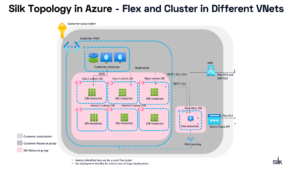About Silk
Silk offers the flexibility and high performance that organizations need to leverage the public cloud. The Silk Data Virtualization Platform is a combination of tested and packaged software and services. Silk provides a rich set of data services, machine learning, analytics, and policy-based automation and orchestration.
Use this guide to learn about the prerequisites to successfully deploy Silk onto your instance of Microsoft Azure.
Refer to the following guides for more information about the prerequisites, steps involved, architecture, security, and networking requirements to successfully deploy Silk onto your instance of Microsoft Azure.
- Deploying Silk – Overview & Background
- How to Deploy Silk
- Architecture Requirements to Deploy Silk
- Security Requirements to Deploy Silk
- Networking Requirements to Deploy Silk
Silk System Overview
The Silk Data Virtualization Platform sits between your cloud storage infrastructure and cloud databases. Silk uses a unique architecture to allow you to maximize your storage capacity on the cloud while providing accelerated performance.
Silk Flex
Silk Flex is our data orchestration platform for managing resources in the public cloud. Silk Flex delivers an on-demand ability to compose, optimize, manage, and decommission resources as needed to support application Service Level Agreements (SLAs) from within the Silk Data Virtualization Platform. Silk Flex orchestrates cloud resources as new workloads emerge, move, and evolve over time.
Silk VisionOS
Silk VisionOS provides a rich set of tools to monitor and manage the Silk Data Virtualization Platform. These management services do not require additional hardware resources.
Silk Cloud Architecture
Refer to Figure 1 below for the Silk Architecture in Azure.
Figure 1: Silk Architecture in Azure
Silk Data Pod (SDP)
The Silk public cloud architecture consists of the following:
- c.node
- m.node
A Silk Data Pod contains a minimum of two (2) c.nodes and one (1) m.node.
c.node
The c.node is the compute/controller node. A minimum of two (2) c.nodes is required to build a Silk Data Pod (SDP) and for redundancy.
Note: You can scale to a maximum of eight (8) c.nodes in Microsoft Azure.
m.node
The m.node is the media node that stores your data and applications. At least one (1) m.node is required for data capacity. Each m.node is made up of multiple d.nodes based on type and configuration (Table 1).
Table 1: Number of d.nodes per m.node based on type and configuration.
| Type | Configuration | Number of d.nodes |
| VM-based d.node | 14 + 2 | 16 |
| Pv2 based d.node | 7 + 2 | 9 |
Note: VM = Virtual Machine. Pv2 = Azure Premium SSD Version 2
The number of m.nodes you need is based on your sizing strategy. One m.node should be sufficient for most data sets. For larger data sets, you can add more m.nodes – up to 4 with VM based d.nodes or 3 with Pv2 based d.nodes.
Supported Regions
Silk on VM supports the Lsv3 and Lasv3 virtual machine families.
Silk currently supports using Lsv3 d.nodes in the following Azure regions
- East Asia
- Southeast Asia
- Australia East
- Australia Southeast
- Brazil South
- Canada Central
- North Europe
- West Europe
- France Central
- Germany West Central
- Central India
- Japan East
- Qatar Central
- Sweden Central
- UK South
- Central US
- East US
- East US 2
- North Central US
- South Central US
- West US
- West US 2
Silk currently supports using Lasv3 d.nodes in the following Azure regions:
- East Asia
- Southeast Asia
- Australia East
- Brazil South
- Brazil Southeast
- Canada Central
- Canada East
- North Europe
- West Europe
- France Central
- France South
- Japan East
- Norway East
- Sweden Central
- Sweden South
- Switzerland North
- UAE North
- UK South
- UK West
- Central US
- East US
- East US 2
- North Central US
- South Central US
- West US
- West US 2
- West US 3
Additionally, Silk currently supports using Silk on Pv2 (Azure Premium SSD Version 2) in the following Azure regions:
- East US
- East US 2
- West US 2
- North Europe
- West Europe
Refer to the Microsoft Azure Global Infrastructure Guide for the most up to date information on supported regions. Silk follows Azure’s supported regions for these components closely, with limited exceptions.
Overview of the Silk Deployment Process
There are 3 main steps involved in deploying Silk to your instance of Microsoft Azure (Figure 2):
- Complete the Silk Checklist
- Deploy Silk Flex from the Microsoft Azure Marketplace
- Deploy the Silk Data Pod from Silk Flex
Figure 2: Overview of the 3 Step Silk Deployment Process
Prerequisites & Silk Architecture Considerations
There are several prerequisites to consider before deploying Silk. Going through the prerequisites will enable you to complete the Silk Checklist.
During the onboarding process, your Silk Solution Architect or Cloud Infrastructure Engineer Account Manager will send you the Silk Checklist via email and will arrange time to review the checklist with you. The data provided in the Silk Checklist will facilitate the deployment process. Silk will also use the information provided to create the Cluster Configuration file used in deploying the Silk Flex cluster.
Please take the time to complete the Silk Checklist before starting the deployment process.
Note: Be sure you have discussed the prerequisites with your internal team ahead of time to help speed up the checklist intake process.
Additional Recommendations
After deploying Silk Flex and a Silk Data Pod (SDP) for the first time, Silk requests a VM Instance with internet access to download Java and vdbench packages, to validate the Silk deployment.


